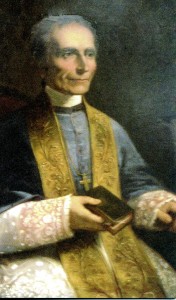On June 26, 1839, Servant of God, Simon Gabriel Brute de Remur breathed his last. After suffering the effects of Tuberculosis, the “Saintly Bishop” (as he was always referred to), died at about 1:30 A.M. The bishop had written a letter on June 18th, knowing that he was going to die soon. This letter was addressed to all the people of his diocese, Catholic or not. He told them that “…in life, or in death, I humbly rejoice before my God.”.
Brute had labored for five short years as bishop. He had seen many of his priests die before their time and now he himself was about to go. Although he was always “French” and loved  his native Brittany, he also truly loved the Church in Indiana. He spent almost 20 years in Maryland ministering to Elizabeth Ann Seton and the Sisters of Charity, as well as to the colleges of St. Mary’s, the one in Baltimore, which was the first seminary in the United States and remains open to this day, and Emmitsburg, known as “The Mount”, the second oldest Catholic College in the United States which Brute referred to as his “beloved mountain”. Yet, he took to this new place, Indiana, as though it had always been his home.
his native Brittany, he also truly loved the Church in Indiana. He spent almost 20 years in Maryland ministering to Elizabeth Ann Seton and the Sisters of Charity, as well as to the colleges of St. Mary’s, the one in Baltimore, which was the first seminary in the United States and remains open to this day, and Emmitsburg, known as “The Mount”, the second oldest Catholic College in the United States which Brute referred to as his “beloved mountain”. Yet, he took to this new place, Indiana, as though it had always been his home.
Brute had a great deal of influence on the Church in America and not just in Indiana. Having been a theologian sought out by many bishops, especially the bishops of Baltimore, Brutés thoughts and words were highly prized. He had an opinion and always a learned opinion, on just about everything having to do with the American Church.
In his last days he was ministered to by Father John (or Jean) Vabret, a member of the French, “Society of Eudists” who were asked to run St. Gabriel Seminary at Vincennes. Ironically, there is very little known about Vabret. The Eudists eventually left the diocese and Vabret’s fate is unknown.
After his death, Elihu Stout, editor of the Vincennes newspaper, the Western Sun, wrote:
The news of his death produced a general and almost unanimous expression of grief amongst our citizens: and well have we cause to lament this even, for to many, very many he was dear; to the one as a friend, to the other as a comforter, to the third as a teacher or literary companion, and to all as a pattern of goodness, morality and pure piety. His character was truly amiable and his manners so conciliating, that whenever he could not make friends, he was sure not to make enemies and we can safely affirm, that he died without the latter.
Perhaps the best tribute to Brute came from a man who arrived in the United States at the same time as Brute, (1810), but who was not ordained until much later, reportedly at the urging of Simon Brute. His name was Anthony Deydier, founder of the Church of the Assumption at Evansville. He himself was a very saintly man and he preached at the 1844 Diocesan Synod. In his sermon he said of Brute:
“Is it not true that when he was with us, we did not feel our weariness? Is it not true that nothing was hard to us; that we scarcely knew we were poor, though really devoid of every necessity of life? …These are men whose labors we have to continue to perpetuate–the models we have for our imitation in life and in death!”
Brute was buried on June 28, 1839 in the crypt of the (Old) Cathedral of St. Francis Xavier in Vincennes. Since that time, there have continued to be efforts made on Bishop Brutés behalf to make his name and his work known. In 2005, Archbishop Daniel Buechlein, retired Archbishop of Indianapolis, began the long and arduous process to seek canonization for Brute. There have been schools named in his honor. For many years the Archdiocese ran the Bishop Brute Latin School. Archbishop Buechlein began the Bishop Brute College Seminary which is affiliated with Marian University in Indianapolis.